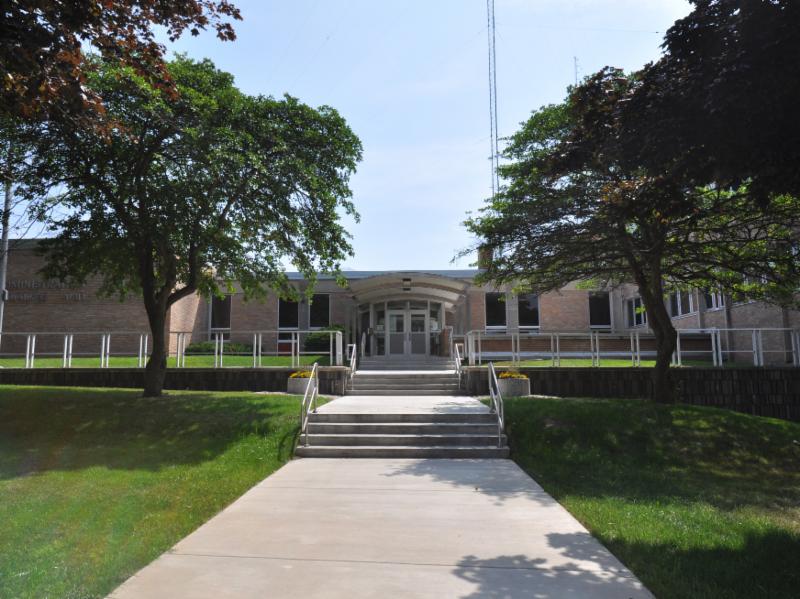MPS Program Offers “Ambitious Instruction”
Will new approach mean more skills taught or more teaching to the test?

Milwaukee Public Schools Office of School Administration, 5225 W. Vliet St. Photo courtesy of Milwaukee Public Schools.
For two hours on Wednesday evening, Oct. 16, Milwaukee Public Schools Superintendent Keith Posley and his staff outlined before the school board their vision of “Ambitious Instruction.” Board members complimented the administration on a well-developed instructional plan to raise academic achievement. But there was also an undercurrent of skepticism from board members that the administration was leading the district astray in pursuit of standardized-test benchmarks in reading, writing and mathematics.
Holding Ambitious Instruction is like holding in one’s hand a scoopful of sand from the seashore. No two people hold the exact concept in the same way. “It’s good teaching from bell to bell,” distilled Posley.
But school board member Bob Peterson reacted to the “bell to bell” reference by recalling that a previous superintendent, Gregory Thornton, wanted students to dive into their textbooks almost immediately on the first day of school. Thornton wasn’t happy seeing teachers handing out homemade cookies and playing name games to get to know each other when he toured a school on the first day. Peterson, then president of the teachers’ union, MTEA, went along on that first-day-of-school tour. Peterson was just as interested in the human interaction as he was in academic achievement. Yes, we should make students “College and Career ready,” said Peterson. But he also wanted to add a third “C” – “Civic ready.”
School board member Tony Baez is even more critical. “We should start giving priority to the arts, to music, to languages, things that engage kids and teachers. The kinds of things that address basic human issues of communication, of people coming together.”
Milwaukee is a microcosm of the nation
What is happening in Milwaukee Public Schools is a microcosm of what is happening throughout Wisconsin and nationally. More than 17 years after the inception of No Child Left Behind, a federal program which focused on basic skills and test scores — a program which often deemphasized art, emotional and creative skills — a backlash has taken place, emphasizing music, art, civics, and human interaction.
The new federal program, Every Student Succeeds Act (ESSA), has narrowed the use of standardized tests using other measurements to determine the achievement of students and schools.
Milwaukee Public Schools chief academic officer Jeremiah Holiday emphasizes that Ambitious Instruction and other skills, including instruction in music and arts, are not mutually exclusive. One can make the argument that good teaching, which includes the arts and emotional/creative skills, will help raise academic performance.
School board president Larry Miller agrees. Properly understood, Ambitious Instruction includes “a whole variation of approaches that are classroom centered,” says Miller. That includes all aspects of learning, not just diving into basic textbooks in reading, writing and math.
“None of this comes naturally,” Miller points out. With minimal training, many teachers are likely to go to training sessions, nod their heads in agreement, and then go back to their classrooms and teach the way they have always done.
The measure of success is still standardized test scores
How do we know if Ambitious Instruction is being followed? Holiday admits, “We are looking at the achievement of our students.” And that means looking at standardized tests.
Some teachers may just cut to the chase and teach to the test. Teachers need extensive training, says Miller, and his conversations with Posley indicate that the superintendent struggles to have all the necessary resources to do that proper training.
Miller points to San Antonio, a district which has shown success using a similar program. Miller hopes that Milwaukee can show similar results in its second year of Ambitious Instruction.
“I’m waiting for best practices and data to show how it is working. If it is working in a particular classroom, tell me about it. Bring that teacher in so she can talk about it,” says Miller. “I need to hear those things from Milwaukee.” So far what he has heard from Holiday, he says, is pretty theoretical with few concrete examples.
Holiday admits that, while numerous studies support individual components in Ambitious Instruction, he can’t point to studies that systematically analyze the effectiveness of the basket of components taken together.
Will Ambitious Instruction squeeze out art?
School board member Megan O’Halloran is thrilled that the board passed a resolution that will extend art, music, and other programs principally to inner city schools that have been underserved, but she is worried that, given the district’s limited resources, Ambitious Instruction will squeeze out other programs.
O’Halloran remembers that, as a student in an elementary school in Shorewood, her school had two gym teachers, a librarian, art teacher and music teacher, and she was able to learn the flute. She compares that with her own daughter attending the MPS school Fratney. “My daughter didn’t have half that. She had gym every other week. They had a full-time librarian, and an art teacher, but a patchwork music instruction. And I don’t think that is fair.”
“The system is rigged against us,” says O’Halloran. “If the test scores are not there, that is the opening to privatize or Madison needing to say, ‘Things aren’t going well, so we need to take action.’’’
And that may mean further constraints on creativity and flexibility in the classroom.
Reprinted with permission of Wisconsin Examiner.
Political Contributions Tracker
Displaying political contributions between people mentioned in this story. Learn more.
- January 24, 2019 - Bob Peterson received $25 from Megan O’Halloran
- January 14, 2019 - Bob Peterson received $1,000 from Larry Miller
- November 29, 2018 - Bob Peterson received $50 from Tony Baez
- August 26, 2018 - Bob Peterson received $50 from Tony Baez
- August 26, 2018 - Bob Peterson received $20 from Megan O’Halloran
The Educator
-
The School Policing Blindspot
 Jul 14th, 2020 by Terry Falk
Jul 14th, 2020 by Terry Falk
-
The Rationale for MPS Referendum
 Jan 14th, 2020 by Terry Falk
Jan 14th, 2020 by Terry Falk
-
How Does Residency Change Affect Teachers?
 Jan 2nd, 2020 by Terry Falk
Jan 2nd, 2020 by Terry Falk






















The only way to pack all of these ideas into a school year is to length the school year. This does not necessarily mean more school days but rather longer times between semesters for reflection or catch up. Many of the enrichment activities suggested here would fit well in a two or three week “tween semester”; in fact, each spring I receive a catalog from MPS filled with fun things to do. Give students the time to do them. In addition, a longer school year (and a shorter summer) will prevent summer backsliding. It will also give a break to all the working parents who need to arrange day care. A longer school year should be part of the plan if MPS instructors are truly ambitious.